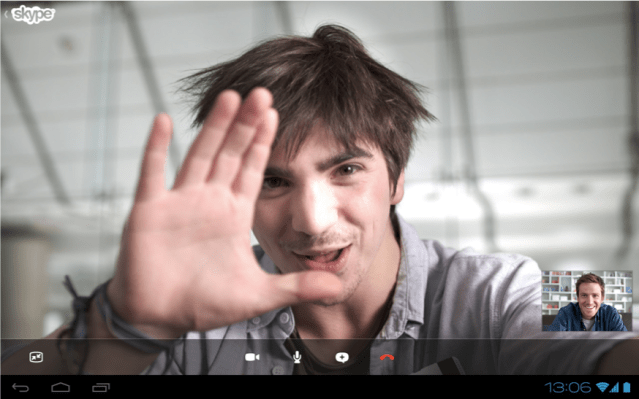Skype now has 280 million monthly users, and mobile a been a major part of Skype’s growth story in the last few years. The company’s iPhone app is regularly near the top of the rankings for Apple’s free apps, and Skype is still expanding to new horizons for the service, for example, offering WiFi and a new app for the tablet-focused Windows 8, a stablemate at Microsoft. Today, though, it’s the turn of Android, with the release of Skype 3.0. This is the company’s biggest upgrade to the Android app in over a year, and like the Windows 8 release, this one was built with tablets in mind.
The Android phone and tablet market is a pretty fragmented space, with a number of OEMs developing devices. While Samsung is currently dominating in smartphones, the picture is more murky for tablets, where a number of OEMs have similarly sized, smallish shares. (This study yesterday from Adfonic, which lists the top ten most popular Android tablets on its ad network, underscores that state of affairs.)
But OEMs are just one problem: there are even more screen sizes to consider than there are OEMs working on them. Still, as analysts have been pointing out, Android tablets’ market share, collectively, continues to grow against Apple’s iPad, so developing for them is becoming more and more essential.
In the past, Skype has been criticized for its Android app, and has been gradual — but not universal— in supporting different tablets for services like video calls. That’s a big deal, considering how important video calls have become to Skype’s business: in its current run rate of 300 billion annual call minutes, half of those are video calls, Skype says.
Despite these two issues, Skype has managed to become the most popular video calling app on the Android platform. A spokesperson tells me that to date it has been downloaded 100 million times (that means 30 million downloads since the end of June, when it reported 70 million Android downloads).
The new Android app finally squares that circle: capitalizing on its popularity, Skype says that it will support all tablet and smartphone shapes, sizes and brands, automatically formatting to whatever size the screen is to offer all of its features, including video calls.
“Now you can share the moment, a photo or a smile on the most popular Android tablets including the Samsung Galaxy Tab 2, the Google Nexus 7, Acer Iconia, Asus Transformer Prime, Motorola Xoom and Sony S,” the company writes in a blog post. “And with our redesigned look and feel, Skype looks great no matter what screen size you have – either on a smaller Android phone or the more spacious display of your tablet.”
Similarly, Skype is looking to raise its game with sound quality by finally adding in its SILK audio codec to its Android app.
The SILK codec gives Skype services “wideband” audio quality, and seems designed with mobile in mind. Its purpose is to provide a good-sounding, and consistent experience, regardless of the quality of the data network.
Considering that on a mobile device you may constantly be switching from cell to cell, and moving to WiFi, having a voice service that navigates that seems essential. Skype has been using the SILK codec since 2010, and it is already live on its iOS app, so this is about bringing Android up to speed with what Skype is doing on other platforms.
As with the rest of the the Skype experience globally, the app now offers users the ability to log in using their Windows credentials — a sign of how the company continues to integrate with its new owner.
